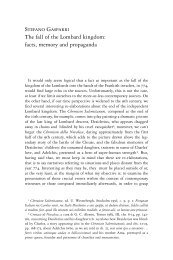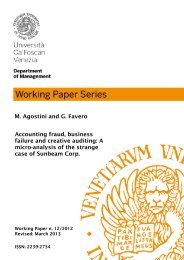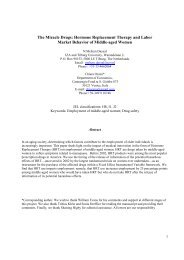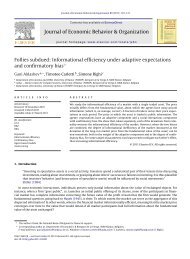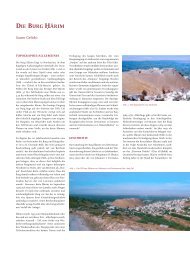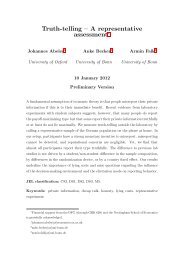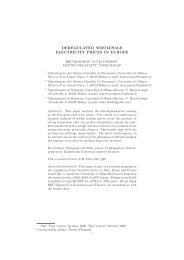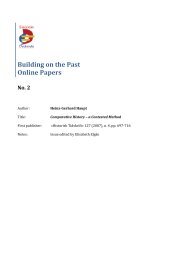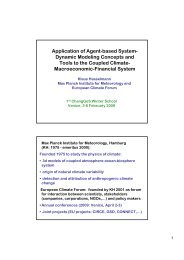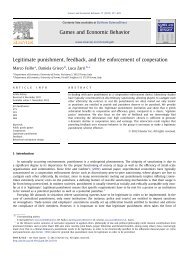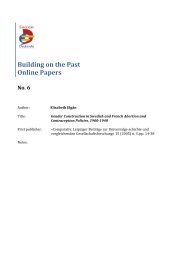The pilot area of Auronzo di Cadore (Belluno) - Università Ca
The pilot area of Auronzo di Cadore (Belluno) - Università Ca
The pilot area of Auronzo di Cadore (Belluno) - Università Ca
Create successful ePaper yourself
Turn your PDF publications into a flip-book with our unique Google optimized e-Paper software.
Box 1<br />
<strong>The</strong> report in brief<br />
2 / Veneto Region’s case study:<br />
<strong>Auronzo</strong> <strong>di</strong> <strong><strong>Ca</strong>dore</strong><br />
Climate change is already significantly affecting the European Alpine Region<br />
beyond the average temperature signals that have been registered at a<br />
global level (IPCC 2007). Not even climate sceptics may deny the evidence<br />
<strong>of</strong> a 50% decrease <strong>of</strong> glaciers’ volume since 1850 (<strong>Ca</strong>stellari 2008). Establishing<br />
whether this change is human-induced or not remains beyond the<br />
scope <strong>of</strong> this study, which explores what it may imply for winter tourism<br />
in the Alps and how local development can be driven to take this new state<br />
into account.<br />
2.1 / Research objective<br />
<strong>The</strong> ultimate aim <strong>of</strong> this study was to <strong>di</strong>scuss about the future <strong>of</strong> <strong>Auronzo</strong><br />
with its people through a significant set <strong>of</strong> representatives, and more specifically<br />
about the prospects for revitalising winter tourism’s performances<br />
in a sustainable manner and the possible strategies to achieve that goal.<br />
This report <strong>di</strong>scusses the activities carried out by the research team in order<br />
to achieve this objective.<br />
Context / Municipality <strong>of</strong> <strong>Auronzo</strong> <strong>di</strong> <strong><strong>Ca</strong>dore</strong> located in the province <strong>of</strong><br />
<strong>Belluno</strong>, in the Veneto Region, in the North-east <strong>of</strong> Italy. It covers a vast<br />
<strong>area</strong> (22.000 ha) which includes Misurina with its lake and the most famous<br />
mountain <strong>of</strong> the Dolomites, namely the “Three Peaks <strong>of</strong> Lavaredo”<br />
part <strong>of</strong> the UNESCO world heritage since 2009.<br />
Problem / How to develop winter tourism in the next 40 years, in a<br />
context <strong>of</strong> climate change scenarios and market demand that are not<br />
favourable?<br />
Objectives / To compare four adaptation strategies: a. the pursue <strong>of</strong> the<br />
tra<strong>di</strong>tional downhill ski-intensive para<strong>di</strong>gm (SKINT), b. an alternative<br />
light ski-oriented post-modern development (ALTSKI), c. the process <strong>of</strong><br />
<strong>di</strong>versification and enlargement <strong>of</strong> tourist <strong>of</strong>fer beyond-snow (BYDSNW),<br />
d. no change from present situation or, in other words, “business as<br />
usual”(BAU).<br />
Of specific interest / <strong>The</strong> focus on holistic and dynamic socio-ecosystem<br />
analysis; / <strong>The</strong> involvement <strong>of</strong> local actors in a participatory process;<br />
/ <strong>The</strong> treatment <strong>of</strong> spatial heterogeneity.<br />
Methods & tools / Implementation <strong>of</strong> the NetSyMoD framework for<br />
participatory modelling and decision support, and in particular the fol-<br />
12




